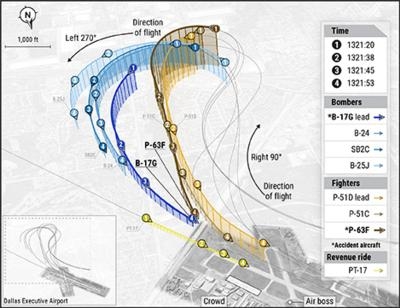Fri, Dec 13, 2024
NTSB Cites Shortcomings In Prebriefing, Oversight, And Risk Control
The National Transportation Safety Board (NTSB), in a media release on December 9, points to inadequate planning as the primary factor leading to the fatal mid-air collision of a Boeing B-17G bomber and a Bell P-63F fighter during the Wings Over Dallas air show in November 2022 at Dallas Executive Airport in Texas.

The pilot, copilot, flight engineer, and two scanners in the B-17G and the pilot of the P-63F were fatally injured and both airplanes were destroyed. Both aircraft were operated by the Commemorative Air Force (CAF).
The accident occurred as the eight airplanes in the performance were completing a repositioning turn that involved a 90-degree right turn followed by a 270-degree left turn. The P-63F was in a descending left turn when it struck the left wing of the B-17G from behind.
Using data analysis from a visibility simulation that modeled the aircraft flight paths, altitudes, and roll angles of the airplanes, NTSB investigators determined that the pilots had limited ability to see and avoid each other’s aircraft. This was attributed to the geometry of the flight paths, and obscuration of the pilots’ out-the-window views by aircraft structures.

The NTSB concluded that there was a lack of a prebriefed aircraft separation plan as well as administrative actions to address the predictable risks associated with the series of maneuvers planned for the performance.
Investigators turned up additional safety issues including the lack of a risk assessment plan, unclear communication orders, a lack of requirements for recurrent evaluation of air bosses, inadequate air show safety assessment and reporting issues within the CAF, and insufficient regulatory oversight.
The NTSB also concluded that the circumstances of the accident accentuate the inherent limitations of the see-and-avoid concept for collision avoidance, particularly in the rapidly-moving environment of an air show performance involving multiple dissimilar aircraft.
More News
Its Offerings Are Lighter, Cleaner, and Now Pushing Past 1,000nm on SAF Jet Fuel DeltaHawk’s diesel-powered aircraft lineup has seen incredible upgrades over the last few yea>[...]
The Airplane Experienced A Total Loss Of Engine Power On December 3, 2025, about 1600 central standard time, a Mooney Aircraft Corp. M20K, N57229, was substantially damaged when it>[...]
Make Sure You NEVER Miss A New Story From Aero-News Network Do you ever feel like you never see posts from a certain person or page on Facebook or Instagram? Here’s how you c>[...]
Aero Linx: European Society of Aerospace Medicine (ESAM) As a pan-European, independent forum, it works to promote the safety and health of all persons involved in aviation and spa>[...]
“We are excited to see Wisk achieve this milestone, and I’m so proud of the team that made it possible. The team at Wisk has built advanced technologies across flight c>[...]
 Aero-TV: DeltaHawks Diesel Power Steps Into the Spotlight
Aero-TV: DeltaHawks Diesel Power Steps Into the Spotlight NTSB Prelim: Mooney Aircraft Corp. M20K
NTSB Prelim: Mooney Aircraft Corp. M20K ANN FAQ: Turn On Post Notifications
ANN FAQ: Turn On Post Notifications ANN's Daily Aero-Linx (12.20.25)
ANN's Daily Aero-Linx (12.20.25) Aero-News: Quote of the Day (12.20.25)
Aero-News: Quote of the Day (12.20.25)




